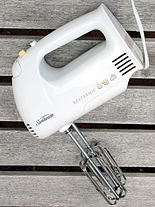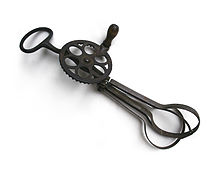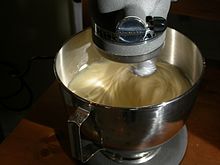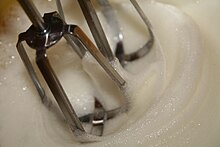"Electrical mixer" redirects here. For the electronic component, see electronic mixer. This article is about the appliance for doughs and batters. For the appliance used for milkshakes, see milkshake machine.

 A hand mixer (left) and stand mixer (right) are two common mixers.
A hand mixer (left) and stand mixer (right) are two common mixers.
A mixer (also called a hand mixer or stand mixer depending on the type) is a kitchen device that uses a gear-driven mechanism to rotate a set of "beaters" in a bowl containing the food or liquids to be prepared by mixing them.
Mixers help automate the repetitive tasks of stirring, whisking or beating. When the beaters are replaced by a dough hook, a mixer may also be used to knead.
A mixer may be a handheld mechanism known as an eggbeater, a handheld motorized beater, or a drill mixer. Stand mixers vary in size from small counter top models for home use to large capacity commercial machines. Stand mixers create the mixing action by either rotating the mixing device vertically (planetary mixers), or by rotating the mixing container (spiral mixers).
History

The mixer with rotating parts was patented in 1856 by Baltimore, Maryland, tinner Ralph Collier. This was followed by E.P. Griffith's whisk patented in England in 1857. Another hand-turned rotary egg beater was patented by J.F. and E.P. Monroe in 1859 in the US. Their egg beater patent was one of the earliest bought up by the Dover Stamping Company, whose Dover egg beaters became a classic American brand. The term "Dover beater" was commonly in use in February 1929, as seen in this recipe from the Gazette newspaper of Cedar Rapids, IA, for "Hur-Mon Bavarian Cream," a whipped dessert recipe featuring gelatin, whipped cream, banana and gingerale. The Monroe design was also manufactured in England. In 1870, Turner Williams of Providence, R.I., invented another Dover egg beater model. In 1884, Willis Johnson of Cincinnati, Ohio, invented new improvements to the egg beater.
The first mixer with electric motor is thought to be the one invented by American Rufus Eastman in 1885. The Hobart Manufacturing Company was an early manufacturer of large commercial mixers, and they say a new model introduced in 1914 played a key role in the mixer part of their business. The Hobart KitchenAid and Sunbeam Mixmaster (first produced 1910) were two very early US brands of electric mixer. Domestic electric mixers were rarely used before the 1920s, when they were adopted more widely for home use.
In 1908 Herbert Johnston, an engineer for the Hobart Manufacturing Company, invented an electric standing mixer. His inspiration came from observing a baker mixing bread dough with a metal spoon; soon he was toying with a mechanical counterpart. By 1915, his 20-gallon (80 L) mixer was standard equipment for most large bakeries. In 1919, Hobart introduced the Kitchen Aid Food Preparer (stand mixer) for the home.
Older models of mixers originally listed each speed by name of operation (ex: Beat-Whip would be high speed if it is a 3-speed mixer); they are now listed by number.
Variants
Eggbeater

An eggbeater is a handheld device with a crank on the side geared to one or more beaters. The user grips the handle with one hand and operates the crank with the other, creating the rotary action.
Stand mixer


Stand mixers mount the motor driving the rotary action in a frame or stand which bears the weight of the device. Stand mixers are larger and have more powerful motors than their hand-held counterparts. They generally have a special bowl that is locked in place while the mixer is operating. A typical home stand mixer will include a wire whisk for whipping creams and egg whites; a flat beater for mixing batters; and a dough hook for kneading. Stand mixers are categorized as either spiral or planetary, based on whether or not the bowl is rotated.
Stand mixers are generally available in either counter top (also called bench) or floor models. Heavy duty commercial models can have bowl capacities well in excess of 25 US gallons (95 L) and weigh thousands of pounds (kilograms) but more typical home and light commercial models are equipped with bowls of around 1 US gal (3.8 L). Whether a mixer is a counter top or floor model depends on its size. Mixers that are 5 US gal (19 L) in size or smaller tend to be counter top mixers, while larger mixers tend to be floor models due to their size and weight.
Spiral vs. planetary stand mixers
Spiral mixers are specialist tools for mixing dough. A spiral-shaped agitator counter-rotates while the powered bowl spins in the opposite direction. This method enables spiral mixers to mix the same size dough batch much quicker and with less under-mixed dough than a similarly powered planetary mixer. Spiral mixers can mix dough with less agitator friction than planetary mixers. This allows the dough to be mixed without increasing its temperature, ensuring the dough can rise properly. Spiral mixers are preferred for thicker products, such as dough for pizza, bagels or naan bread.
Planetary mixers consist of a bowl and an agitator. The bowl remains static, whilst the agitator is rapidly moved around the bowl to mix its contents. With the ability to mix a wide variety of ingredients, planetary mixers are more versatile than their spiral counterparts. Planetary mixers can be used to whip and blend, whereas spiral mixers cannot.
Hand mixer

A hand mixer is a hand-held mixing device. A handle is mounted over an enclosure containing the motor. The motor drives the beaters which are immersed in the food to perform the mixing action. The motor must be lightweight as it is supported by the user during use. The user may use any suitable kitchen container to hold the ingredients while mixing.
The first handheld electric mixer patent was submitted by Sunbeam Corporation in 1953 and granted in 1961.
Dough mixer
A dough mixer is used for household or industrial purposes. It is used for kneading large quantities of dough. It is electrical, having timers and various controls to suit the user's needs. Some features of dough blenders include high speed, low speed and bowl reverse (these can be combined into a programme) and a kneading bar in the centre of the bowl.
See also
- Whisk, a manual kitchen utensil for mixing and whipping
- Industrial mixer
- Blender, an electric appliance with small blades at the bottom of a jar
- Milkshake machine, an electric appliance with a top-mounted agitator
- Dough scraper
- Pastry blender
- Kenwood Chef, a British food mixer
- Electrolux Ankarsrum Assistent, a Swedish made mixer that moves the bowl, not the implements
References
- U.S. patent 16,267
- U.S. patent 23,694
- "Feeding America - Egg Beaters". Digital.lib.msu.edu. Archived from the original on 25 September 2011. Retrieved 30 September 2012.
- ^ "Early rotary egg beaters". Homethingspast.com. 2 August 2012. Archived from the original on 2 October 2012. Retrieved 30 September 2012.
- "Hur-Mon Bavarian Cream Recipe". The Gazette. 3 February 1929. p. 24. Archived from the original on 28 February 2023. Retrieved 28 February 2023.
- U.S. patent 103,811
- "Patent Images". pdfpiw.uspto.gov. Archived from the original on 24 January 2018. Retrieved 23 January 2018.
- U.S. patent 330,829
- ^ Katz, Solomon H.; Weaver, William Woys (2003). Katz and Weaver, Encyclopedia of Food and Culture: Food production to Nuts, Scribner 2003, pages 323-333. Scribner. ISBN 9780684805665. Retrieved 30 September 2012.
- Vegetarian Times, Oct 2002, pages 69-70. October 2002. Archived from the original on 25 May 2023. Retrieved 30 September 2012.
- Phil Ament. "Fascinating facts about the invention of the Standing Mixer by Herbert Johnson in 1908". Ideafinder.com. Archived from the original on 1 October 2013. Retrieved 30 September 2012.
- "Hobart - Our History". Hobartcorp.com. Archived from the original on 10 July 2017. Retrieved 30 September 2012.
- Frederik Nebeker, Dawn of the electronic age: electrical technologies in the shaping of the modern world, 1914 to 1945. Wiley. 2009. pp. 131 and 238. ISBN 9780470409749. Archived from the original on 12 July 2023. Retrieved 30 September 2012.
- Phil Ament (5 May 2015). "Mixer History - Invention of the Mixer". ideafinder.com. Archived from the original on 1 October 2013. Retrieved 5 May 2015.
- "Complete Guide To Buying Mixers". Kinnek.com. Archived from the original on 14 January 2013. Retrieved 6 January 2012.
- "Difference Between Spiral and Planetary Mixers". ACityDiscount.com. Archived from the original on 15 December 2018. Retrieved 12 December 2018.
- US patent 2987636A, Ivar Jepson, "Electric mixer", issued 1961-06-06, assigned to Sunbeam Corp
External links
 Eggbeater dynamics in parabolic case at Wikibooks
Eggbeater dynamics in parabolic case at Wikibooks